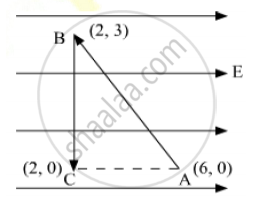Advertisements
Advertisements
प्रश्न
Draw a labelled diagram of Van de Graaff generator. State its working principle to show how by introducing a small charged sphere into a larger sphere, a large amount of charge can be transferred to the outer sphere. State the use of this machine and also point out its limitations.
उत्तर
Van de Graaff generator is a device used for building up high potential differences of the order of a few million volts.
Principle − It is based on the principle that charge given a hollow conductor is transferred to the outer surface and is distributed uniformly over it.
Construction:

It consists of a large spherical conducting shell (S) supported over the insulating pillars. A long narrow belt of insulating material is wound around two pulleys P1 and P2. B1 and B2 are two sharply pointed metal combs. B1 is called the spray comb and B2 is called the collecting comb.
Working − The spray comb is given a positive potential by a high tension source. The positive charge gets sprayed on the belt.
As the belt moves and reaches the sphere, a negative charge is induced on the sharp ends of the collecting comb B2 and an equal positive charge is induced on the farther end of B2.
This positive charge shifts immediately to the outer surface of S. Due to discharging action of sharp points of B2, the positive charge on the belt is neutralised. The uncharged belt returns downwards and collects the positive charge from B1, which in turn is collected by B2. This process is repeated and the positive charge on S goes on accumulating. In this way, voltage differences of as much as 6 or 8 million volts (with respect to the ground) can be built up
Use: Van de Graaff generator generates high potential differences that are used to accelerate charged particles such as electrons, protons, ions, etc. used for nuclear disintegration.
Limitations: 1) It's a series combination that allows only one route for the movement of charge.
2) It can accelerate only the charged particles not the uncharged particles.
APPEARS IN
संबंधित प्रश्न
Define 1 volt PD.
A test charge ‘q’ is moved without acceleration from A to C along the path from A to B and then from B to C in electric field E as shown in the figure. (i) Calculate the potential difference between A and C. (ii) At which point (of the two) is the electric potential more and why?

Find the potential difference between the points A and B and between the points B and C of the figure in steady state.

A charge of `+2.0 xx 10^-8 C` is placed on the positive plate and a charge of `-1.0 xx 10^-8 C` on the negative plate of a parallel-plate capacitor of capacitance `1.2 xx 10^-3 "uF"` . Calculate the potential difference developed between the plates.
A charge of 1 µC is given to one plate of a parallel-plate capacitor of capacitance 0⋅1 µF and a charge of 2 µC is given to the other plate. Find the potential difference developed between the plates.
If a positive charge moves in the direction of the electric field ______.
Two metal pieces having a potential difference of 800 V are 0.02 m apart horizontally. A particle of mass 1.96 × 10–15 kg is suspended in equilibrium between the plates. If e is the elementary charge, then charge on the particle is ______.
On moving a charge of Q coulomb by X cm, W J of work is done, then the potential difference between the points is ______.
A bullet of mass of 2 g is having a charge of 2 µc. Through what potential difference must it be accelerated, starting from rest, to acquire a speed of 10 m/s.
Work done in moving a unit positive charge through a distance of x meter on an equipotential surface is:-
